Key takeaways:
- Online accessibility enhances user experience and fosters empathy, highlighting the need for inclusive design practices.
- Implementing accessible elements like alt text, semantic HTML, and keyboard navigation is crucial for supporting users with disabilities.
- Testing tools and real user feedback are essential in identifying and addressing accessibility barriers on websites.
- Balancing aesthetics and functionality while keeping up with evolving standards poses ongoing challenges in web accessibility efforts.
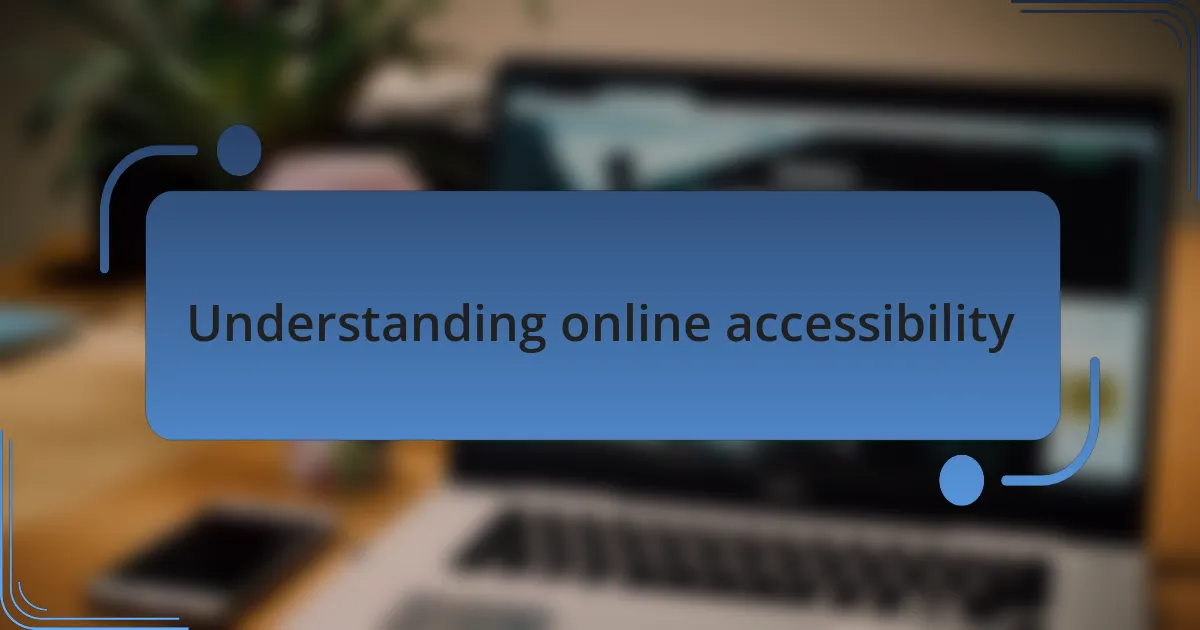
Understanding online accessibility
Accessibility on the web goes beyond simple compliance; it’s about creating an inclusive experience for all users. I remember the first time I encountered a website that offered voice navigation. It opened my eyes to the potential for people with disabilities, and it made me wonder how many websites out there still lack such fundamental features.
Consider this: have you ever tried to navigate a website without a mouse? I did, out of curiosity, as I wanted to understand how the visually impaired experience the internet. I quickly realized that effective keyboard navigation and properly labeled elements are crucial for accessibility. It was a revelation that made me rethink how I design my own projects.
Online accessibility also fosters empathy, urging us to consider how our designs impact others. I often ask myself, “What would my experience be like if I relied on assistive technologies?” This mindset inspires me to prioritize accessible components, enhancing not only usability but also the emotional connection with the audience.
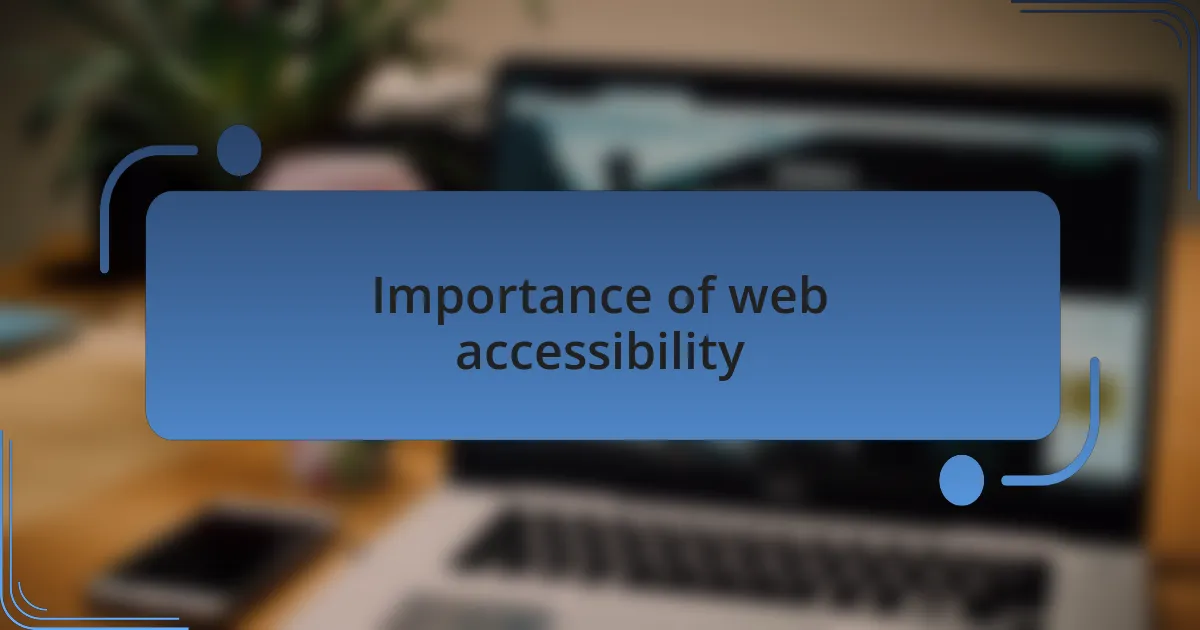
Importance of web accessibility
Web accessibility is essential because it ensures that everyone, regardless of their abilities, can engage with content online. I recall a project where I implemented alt text for images on my website. It was enlightening to witness how users with visual impairments were able to understand the visuals, which underscored the importance of making every aspect of a website accessible.
Have you ever thought about how frustrating it can be to visit a site that doesn’t support screen readers? I vividly remember attempting to use a site that lacked proper ARIA (Accessible Rich Internet Applications) labels. It was a jarring experience that made me realize that accessibility isn’t just a checklist; it significantly impacts users’ experiences and engagement levels. By prioritizing accessible design elements, we create a more welcoming and engaging environment for everyone.
Moreover, accessible websites can lead to broader audiences and increased customer loyalty. One time, I received feedback from a user who appreciated the effort I put into making my site easy to navigate. It was inspiring to see that a few thoughtful adjustments could significantly influence a person’s experience, turning a simple visit into a meaningful connection. This reinforces my belief that web accessibility isn’t just a best practice; it’s a crucial part of web design that can enhance overall satisfaction and inclusivity.
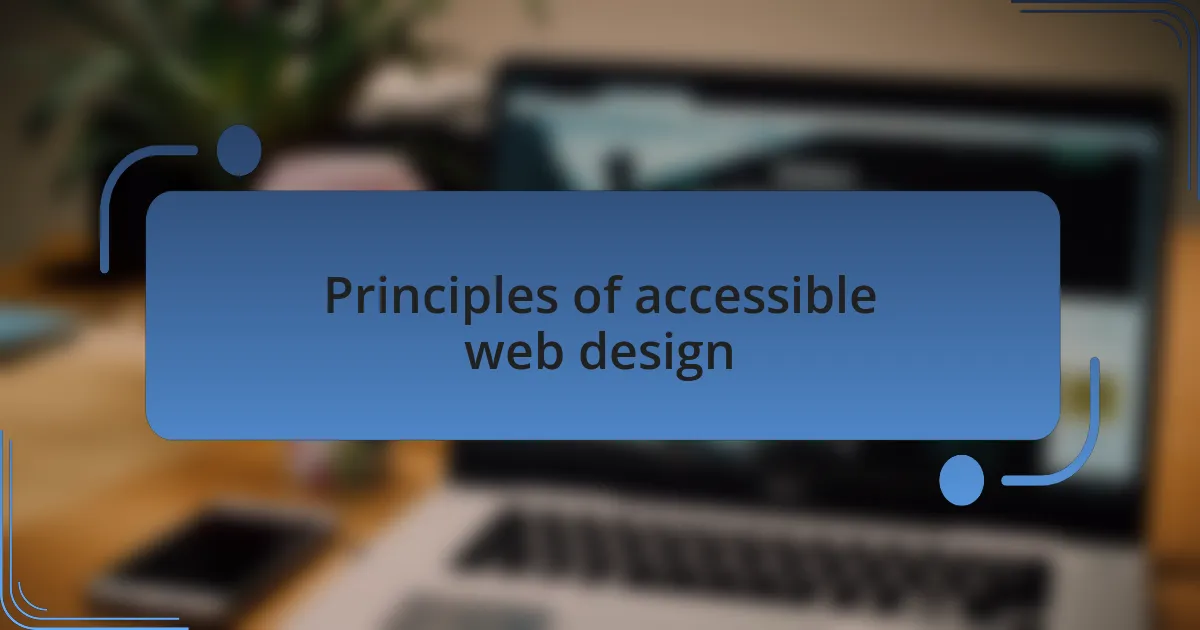
Principles of accessible web design
When it comes to accessible web design, simplicity plays a vital role. I remember a project where I chose a clear, contrasting color palette to improve readability. This choice not only enhanced the visual appeal but also made navigation seamless for users with visual impairments. Imagine the difference it makes for someone struggling to differentiate colors—this principle helps create a smoother experience for everyone.
Another fundamental principle is semantic HTML. I often emphasize this in my projects because using proper tags allows screen readers to interpret the content accurately. For instance, when I implemented headings correctly, I noticed a user with assistive technology effortlessly navigating the site. It was a real eye-opener to witness how much simpler it is for users when we provide them with a logical structure.
Lastly, consider the principle of keyboard navigation. I once had a conversation with a friend who relies solely on keyboard shortcuts. The sheer frustration of being unable to access specific elements on a site without a mouse was palpable. This experience shaped my approach, motivating me to ensure that every interactive element was easily reachable via keyboard, thus promoting independence and equality for all users. Isn’t it rewarding to think about how these small design tweaks can empower others?
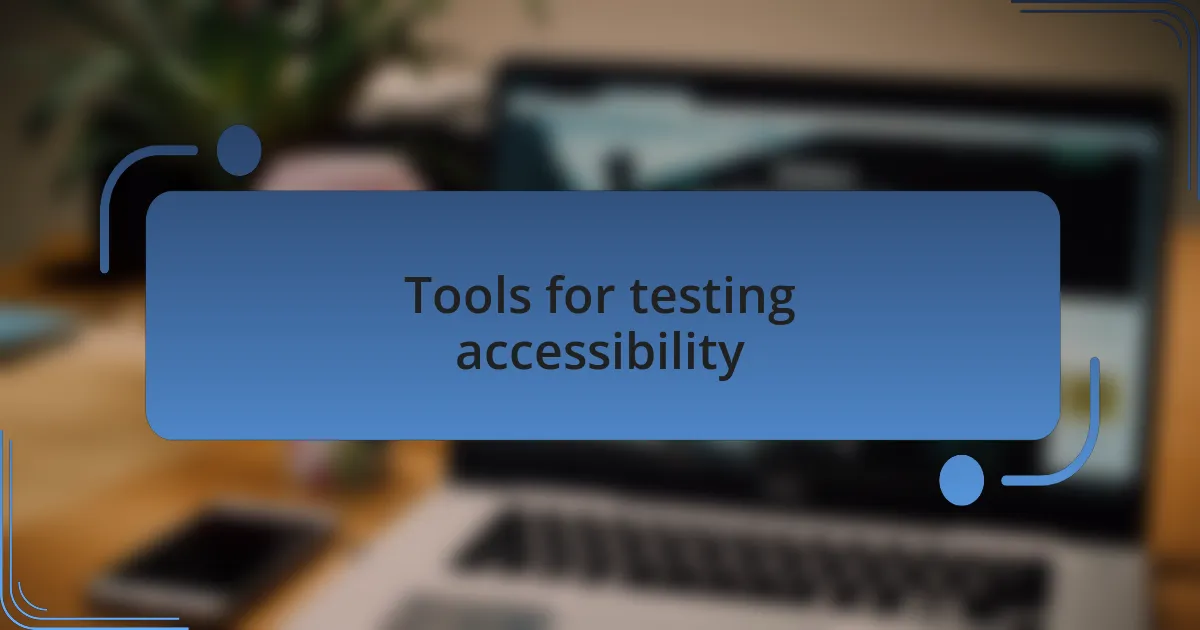
Tools for testing accessibility
When it comes to testing accessibility, tools are essential in identifying barriers that may not be immediately visible. For instance, I once used the WAVE tool on a site I designed, and it unveiled several contrast issues I hadn’t spotted. This experience reminded me that even experienced designers can overlook aspects that affect users with disabilities.
I often turn to automated tools like Axe when assessing website accessibility. One day, while troubleshooting a project, Axe highlighted a missing alternative text for images. That moment was crucial—it reinforced the importance of not just checking the boxes but truly understanding how each element impacts user experience. Do we fully grasp how vital alt text is for individuals relying on screen readers? I now ensure that every image has meaningful descriptions to foster a more inclusive interaction.
In my journey, I’ve found that manual testing complements automated tools effectively. During a usability test session, I observed users navigating my site using screen readers. This real-time feedback was invaluable, as I saw firsthand how they interacted with my design choices. It truly hit me that no tool can replace the insights gained from actual user experiences. Engaging with users provides a depth of understanding that enhances my accessibility efforts immensely.
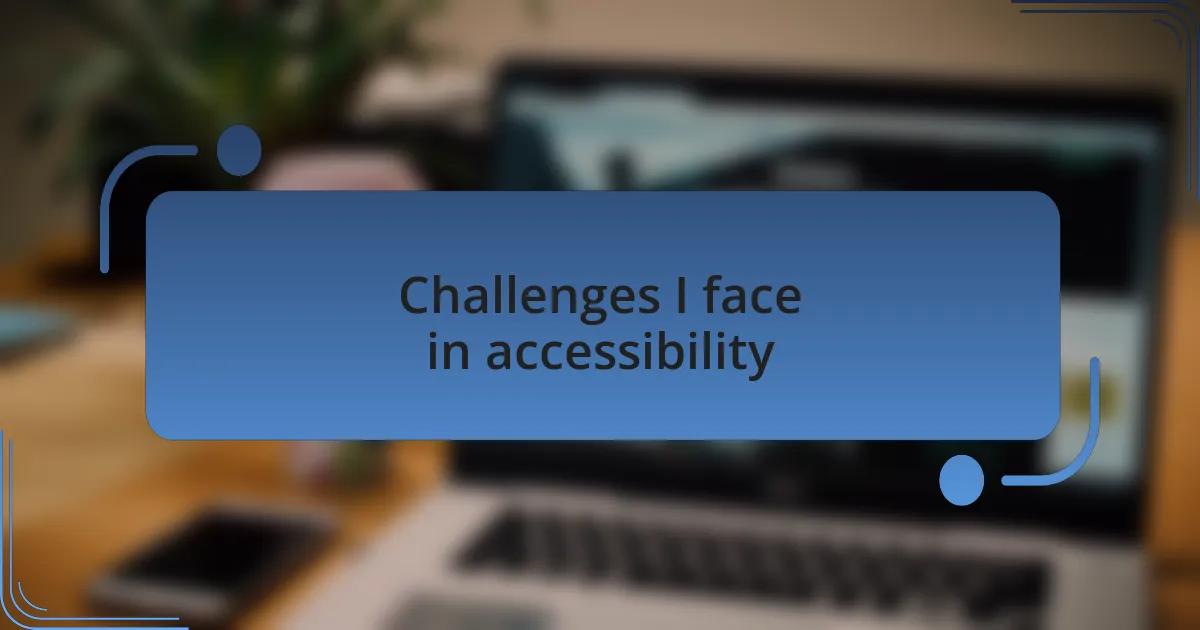
Challenges I face in accessibility
One challenge I consistently encounter in accessibility is balancing aesthetics with functionality. I vividly remember a project where I was torn between a sleek design and ensuring sufficient color contrast. My initial instinct led me to choose a visually appealing but low-contrast color scheme. After receiving feedback from users with visual impairments, I realized how critical it is to prioritize accessibility over mere style. It sparked a question for me: how often do we prioritize looks at the expense of usability?
Another hurdle is keeping up with evolving accessibility standards. I’ve found that just when I think I’ve grasped everything, new guidelines emerge that necessitate further adjustments. Recently, a site I was working on shifted in its compliance requirements, and I had to revisit my designs and implementations. This constant change can be frustrating but also a reminder to embrace a learning mindset. How do I stay ahead in this ever-evolving landscape while ensuring that my designs remain user-friendly?
Finally, collaborating with developers presents its own challenges. One time, while working on a complex project, my accessibility recommendations got lost in translation between design and code implementation. I found myself questioning how to communicate the significance of features like keyboard navigation and ARIA landmarks effectively. This experience emphasized the need for clear dialogue and teamwork, making me realize that accessibility isn’t just my responsibility—it’s a collective effort that requires everyone on the team to be on the same page.
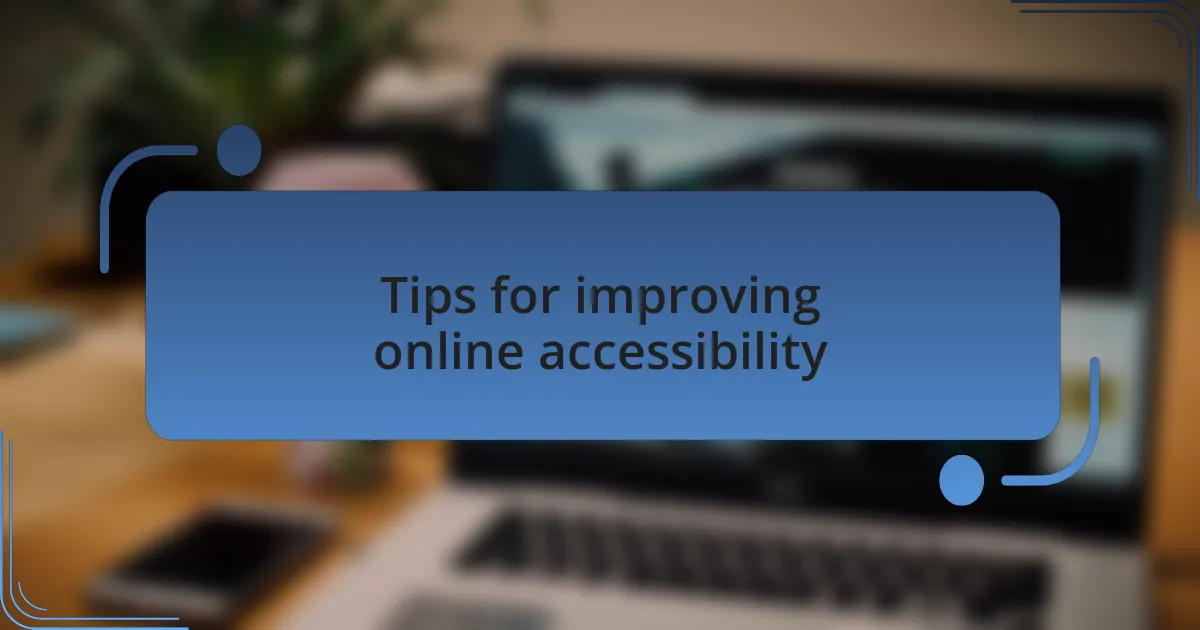
Tips for improving online accessibility
When looking to improve online accessibility, one practical step is to incorporate alternative text for images. I once worked on a website where I overlooked this feature, thinking it was unnecessary for a visually driven design. After realizing that a user with screen-reading software struggled to engage with our visuals, I understood that such descriptions are vital. They don’t just enhance accessibility; they enrich the experience for all users, sparking the question: how much more could we share if we just thought inclusively?
Another key tip is to ensure your website is keyboard navigable. I distinctly remember a time when a user pointed out that they relied solely on their keyboard for navigation. This simple insight compelled me to review our site’s layout. I discovered that many critical features were hidden away and inaccessible. This made me wonder how many users silently face barriers every day because we forget basic usability principles. Ensuring all interactive elements are reachable via keyboard not only supports users with disabilities but also improves overall user experience.
Finally, testing with real users can be a game changer. During one project, I conducted user interviews and tests with individuals who had various accessibility needs. This experience opened my eyes to the nuances I had previously overlooked, like the need for simplified navigation or more intuitive layouts. Listening to their experiences turned what could have been a tedious task into an enlightening opportunity. I often ask myself: how can we genuinely understand our audience if we don’t engage with them directly? Making space for their voices is essential for crafting accessible designs.